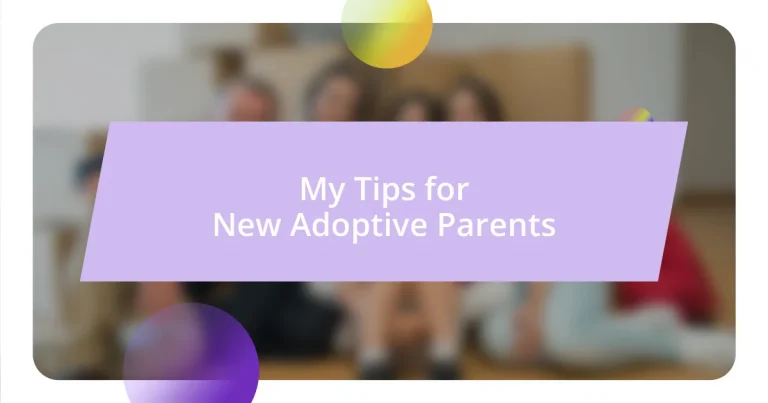Key takeaways:
- Understanding the adoption process and building a support network are critical steps in successfully transitioning into adoptive parenthood.
- Creating a safe and welcoming home environment, alongside establishing routines and boundaries, fosters security for the child.
- Celebrating milestones and seeking professional help when needed can enhance the family’s emotional well-being and strengthen relationships.

Understand the Adoption Process
Understanding the adoption process can feel overwhelming at times, but it’s essential to break it down. I remember the first day I walked into an adoption workshop, filled with a mix of excitement and anxiety. Have you ever felt that rush of both hope and dread about a big change in your life? That workshop was a turning point, helping me grasp the intricate steps involved—from home studies to matching with a child.
The process can vary significantly depending on whether you’re adopting domestically or internationally, with each path having its own nuances. I often found myself puzzled by the legal jargon; it felt like I was stepping into a foreign land. For instance, understanding terms like “finalization” and “post-placement reports” became crucial for me. This is a journey where knowledge truly is power.
One emotional insight I gained was the importance of building a support network along the way. Have you considered who might be your cheerleaders during this process? Sharing my experiences with friends and other adoptive parents not only provided comfort but also valuable advice. Forming connections with others navigating similar paths brought a sense of community that I hadn’t anticipated but desperately needed.

Prepare Your Home Environment
Creating a warm and welcoming home environment is essential for new adoptive parents. I remember the weeks leading up to our child’s arrival were filled with joy and endless preparations. My partner and I transformed our spare room into a cozy sanctuary, filled with colors and items that felt inviting yet safe. The thought of what it would feel like to see our child there for the first time was exhilarating.
When preparing your home, consider these key elements:
- Safety First: Childproof your home by securing furniture, covering outlets, and removing hazards. I found that making the space safe gave me peace of mind.
- Personal Touches: Include family photos and favorite books that reflect your experiences, showing your new child their place in this family.
- Comfort Items: Stock up on toys, blankets, and items that foster a sense of security. I still remember how our child instantly gravitated toward a soft, plush elephant we had waiting.
- Nurturing Spaces: Think about creating areas for quiet time or playtime, which can help in establishing routines. Having a little reading nook turned out to be a cherished spot for both of us.
By infusing your home with these thoughtful touches, you lay the foundation for familiarity and warmth, essential for welcoming your new child.

Build a Support Network
Building a support network is one of the most important ventures you can embark on as a new adoptive parent. I can’t stress enough how beneficial it was for me to connect with others who shared similar experiences. It was not just about getting practical advice, but also about sharing feelings and fears. The honest discussions I had with fellow adoptive parents made me realize I wasn’t alone in this journey but a part of a larger community. Have you ever felt the power of a shared experience? It can be incredibly uplifting.
In my own experience, I found that transitioning into parenthood sometimes felt isolating. I reached out to local adoption groups and online forums, which opened up a wealth of resources. It became my safe space—a place where I could ask any question without fear of judgment and receive genuine support. The friendships that blossomed from these connections were invaluable. They provided me with insights I never would have found in a book. And yes, sharing a good laugh or a comforting word when things got tough made all the difference.
So, how do you start building this support network? Think about engaging with your local community—perhaps attend workshops or support meetings. Reach out via social media to connect with other adoptive families. Participation brings you not just resources but also life-long friendships. The more you engage, the stronger your network will become.
| Support Network Resources | Description |
|---|---|
| Local Adoption Groups | Meet other adoptive families to share experiences and advice. |
| Online Forums | Join discussions and ask questions in a supportive environment. |
| Workshops | Attend workshops to learn about parenting and adoption-related topics. |
| Social Media Groups | Participate in Facebook or Instagram groups focused on adoption. |
| Counseling Services | Access professional support where you can discuss specific concerns. |

Communicate Openly with Your Child
Communicating openly with your child seems straightforward, but it deeply impacts their sense of security. When my child first came home, I discovered that sharing my feelings helped create a safe space for them to express theirs. I made it a point to ask questions about their day and listened intently, which often led to meaningful conversations about their thoughts and fears.
I remember one moment vividly when my child hesitated to talk about their past. It prompted me to open up about my own childhood experiences, creating a bridge of understanding. This mutual sharing not only built trust but also demonstrated that it was okay to show vulnerability. Have you ever realized how a simple conversation could break down the walls of uncertainty?
Encouraging your child to share their feelings is essential, especially in a new environment. I found that using regular family discussions—not just about serious topics, but also about fun things like favorite shows or meals—helped my child feel more integrated. Whether it’s at dinner or during a calming bedtime routine, these open lines invite comfort and joy into your communication. Simple, open dialogue can make a world of difference in nurturing your child’s emotional well-being.

Establish Routines and Boundaries
Establishing routines and boundaries is crucial for creating a sense of security in your new family dynamic. I remember our first few weeks together felt chaotic, with emotions running high and schedules left unstructured. That’s when I decided to implement a consistent bedtime routine, which worked wonders for my child. It not only provided them with predictability but also became a cherished moment for us to bond over bedtime stories, building trust and connection.
I found that clear boundaries help children feel safe, as they know what is expected of them. For instance, when we defined “quiet time” after lunch, it allowed my child to unwind while also giving me a moment to recharge. This structure became a beautifully calming ritual in our day. Have you ever noticed how much more relaxed you feel when you know what to expect? It’s the same for kids—they thrive in environments where they can navigate their world with confidence.
I also learned the importance of consistency; it’s not just a buzzword but a guiding principle. I remember slipping once and letting bedtimes shift during a weekend getaway, thinking it wouldn’t matter. However, my child’s increased anxiety the following week taught me that even slight disruptions could unsettle their sense of stability. So, stick to your routines as much as possible, and remember—when both of you know the rules and the flow of daily life, you’ll create a nurturing atmosphere that fosters growth and understanding.

Celebrate the Adoption Journey
Celebrating the adoption journey is a wonderful way to acknowledge the love and commitment that goes into building your family. I recall throwing a small party to mark the day we finalized our adoption. It was incredible to witness my child’s face light up with joy as friends and family gathered to support us. Have you ever seen how a celebration can bring people closer together? It’s those shared moments that truly strengthen our bonds.
Each milestone in our journey deserves recognition—big or small. I remember celebrating “gotcha day” every year with a special dinner and a little gift that represents a memory from the past year. These traditions not only celebrate our unique story but also provide comfort and stability. I’ve noticed that reflecting on our journey during these times opens up space for heartfelt conversations and helps my child feel valued and understood.
It’s also essential to create visual reminders of your journey—pictures, albums, or even a family artwork project. I once helped my child craft a collage depicting their journey, from the early days to now, and it deepened our connection. Seeing their own growth through these visuals can foster a sense of pride and belonging. Reflecting on where you’ve come from is a great way to reinforce the love that brought you together. How do you plan to celebrate your own adoption journey?

Seek Professional Help if Needed
Sometimes, the adoption journey comes with challenges that can feel overwhelming. I faced moments where I realized that my child needed more support than I could offer alone. Whether it was behavioral issues or emotional struggles, I found that seeking professional help, such as therapy, made a profound difference. Have you ever felt like talking to someone who understands can lift a weight off your shoulders? It certainly helped us to navigate our feelings together.
It’s crucial to recognize that reaching out for assistance is a sign of strength, not weakness. I remember attending a support group for adoptive parents, where I connected with others who shared similar experiences. Listening to their stories not only validated my feelings but also provided practical strategies for addressing tough situations. In my experience, there’s something incredibly comforting about knowing you’re not alone in this journey—why not seek out those connections?
Professional guidance can be a game-changer in understanding your child’s needs. I sought therapy when I noticed my child struggling with anxiety, and it opened up pathways for healing. The therapist helped them express feelings they couldn’t articulate to me, and witnessing that transformation was heartwarming. If you ever feel lost, don’t hesitate to consult with a professional; it might just reveal insights that bring you closer together as a family.














